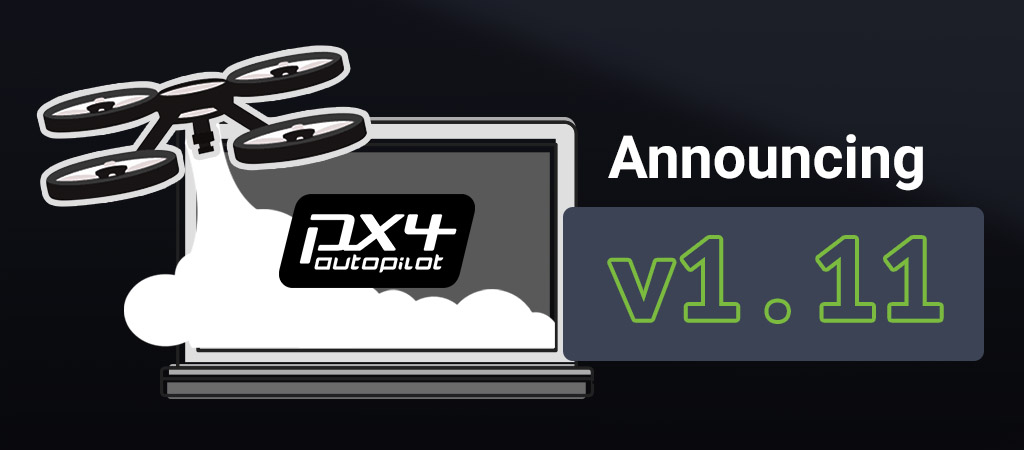
The PX4 team is happy to announce a new version of PX4, v1.11.0. After eight-months (8) of hard work with more than a hundred contributors and two thousand commits, PX4 v1.11 is finally out, and it brings tons of performance updates, new features, and tons of new hardware compatibility. For v1.11.0 the team focused on improving the end-user experience and hardening failsafe operations for all supported vehicles.
How to get the release
You can try the latest release (and older ones) directly from GitHub, you can build the source, or try the pre-built binaries that can be found directly on the tagged release (see links below).
You can also load v1.11.0 directly into your supported flight controller of choice using QGroundControl, through the same procedures as before (see link to documentation below).
What’s in v1.11.0 stable
Release Highlights
- Multicopter hover thrust estimator (#13981)
- Backup yaw estimator for emergency recovery (PX4/ecl#766)
- New Invensense and Bosch IMU drivers enabled everywhere
- Major sensor calibration improvements (Gyro, Mag, Level)
New hover thrust estimator
“The Hover Thrust Estimator (HTE) is a good step towards self-tuned drones. The hover thrust is not only a critical parameter that the user had to set manually before, but also something that can change over time or between flights (e.g.: cargo, change of payload, or crop spraying), and this feature gives improved reliability for multirotors which have changing mass during flight.”
Mathieu Bresciani, Flight Control Engineer at Auterion, and PX4 MultiCopter Maintainer
Read all the details on GitHub PX4/Firmware#13981
Backup yaw estimator for emergency recoveries
The compassless single-GPS yaw mode allows full 3D navigation in the presence of strong magnetic fields, such as trains or ships, and also protects against faulty magnetometers.
Paul Riseborough, PX4 ECL Maintainer.
Read all the details on GitHub PX4/ECL#766
New Invensense and Bosch IMU drivers enabled everywhere
Completely rewritten drivers and framework optimized for flight performance (high rate raw data up to 8 kHz and low end-to-end latency) with configurable low latency sensor pipeline with a new notch filter. This change enables the multicopter rate controller to run synchronized with primary gyro (up to 4 kHz configured via IMU_GYRO_RATEMAX)
This change was made possible thanks to Daniel Agar, PX4 Maintainer
Major sensor calibration improvements
Gyro, Level and Mag calibration times have been dramatically improved. Gyro calibrations are now faster, taking up to 1s to complete, down from 20s, and with an updated “stricter” motion check, the calibration is able to restart itself if minimal motion is detected.
This change was made possible thanks to Beat Kung, Software Engineer at Auterion, and PX4 Maintainer
Read all the details on GitHub PX4/Firmware#13632, PX4/Firmware#13623, PX4/Firmware#13666
Out of the box support for ROS 2
“Interfacing with ROS2 Foxy means now developers are enabled with the latest cutting edge communications middleware and tooling for their flying robots.”
Nuno Marques, Software Engineer at Auterion, and PX4 ROS/RTPS Maintainer
Read all the details on GitHub PX4/Firmware#15227
Smoother motion planning from a companion computer
“Multicopter missions with altitude changes now work how users would expect them to, with the vehicle flying diagonal lines directly between waypoints. This is really important for people planning missions around steep terrain or other vertical obstacles like buildings. Additionally, the bezier trajectory interface lets developers and academics specify precise 4D motions for their vehicles, opening up the possibility of smooth vehicle motion planning from a companion computer. The notch filter allows better vehicle tuning even on airframes with high resonance.”
Julian Kent, Computer Vision Engineer at Auterion, Avoidance Maintainer.
Read all the details on GitHub PX4/Firmware#14279, PX4/Avoidance#555
Support for multiple UAVCAN smart batteries
“Support for UAVCAN V0.1 smart batteries. Supports multiple smart batteries in parallel.”
Alex Klimaj, Founder at Ark Electroniks, PX4 Contributor
Read all the details on GitHub PX4/Firmware#14198
Improved Simulation toolkit
“PX4 now supports FlightGear to support high fidelity aerodynamic models, Gazebo based multivehicle simulations, and simulated payloads to enable users to test on advanced workflows for their simulation benches.”
Jaeyoung Lim, Software Engineer at Auterion, Simulation Tools maintainer
Support for Underwater Vehicles
“It is amazing to see PX4 development over the last few years. After flying and driving we are now entering another domain and dive into the underwater environment with new exciting applications to come! Things are sometimes different underwater, I hope the new UUV support will be a good starting point for people to use px4 for underwater drones.”
Daniel Duecker, Project Lead at HippoCampus
Read all the details on GitHub PX4/Firmware#14079
And many more features and fixes
The full list of new features, changes, and fixes can be found on GitHub, we have also included a link to the full changelog for completeness.
What our community contributors have to say about the release
“The big improvements in the v1.11 release are in improving the structure and organization of the codebase. Simple code is easier to develop on, and easier to maintain, so I expect we’ll be seeing improvements in reliability and testing at the same time as an increase in feature contributions.”
Jacob Crabill, Robotics Lead at Volans-i
This release was brought to you by
The PX4 v1.11 release was made possible thanks to contributions from organizations and individuals who firmly believe in open-source, and are committed to making PX4 the best autopilot solution in the industry. The following list only shows the top ten contributing organizations and developers, but the full list can be found below.
Top Contributing Organizations
- Auterion
- Open Source Contributors (no attribution given to any organization)
- DroneSolutions
- Teal Drones
- CUAV
- Corvus Robotics
- Wingtra
- NXP Semiconductors Netherlands B.V.
- Sunflower Labs
- Vertical Technologies
- See below for the full list.
Top Contributing Developers
- Daniel Agar
- Julian Oes
- Beat Kung
- David Sidrane
- Lorenz Meier
- Matthias Grob
- Nuno Marques
- Julien Lecoeur
- Jacob Dahl
- Jaeyoung Lim
- See below for the full list.
